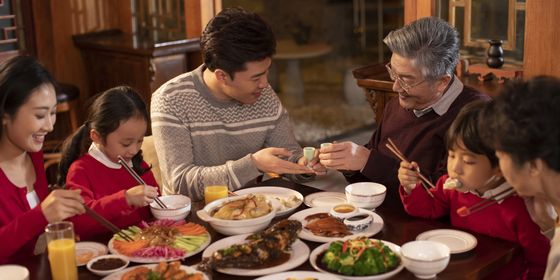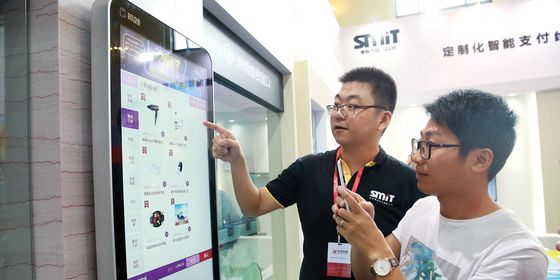How much cash each province gave – and three other economic implications of China’s annual Spring Festival gift tradition
The giving of cash gifts to relatives and friends probably ranks equal alongside food, family, travel, and TV galas as the pillars of the Chinese Spring Festival season.
Known as 压岁钱 (yāsuìqían, “money against misfortune”) when given to children, or simply 红包 (hóngbāo, “red envelope” or “red pocket”), after the festive wrapping in which the money is presented, the many rules of giving and receiving these cash offerings are a source of anxiety to cash-strapped people with big families everywhere.
It used to be difficult to estimate how much money was changing hands every Spring Festival through hongbao—but as mobile applications like WeChat, QQ, and Alipay started to add hongbao-payment to their services, we start to get clearer pictures of just how widespread is the practice.
Note that online and offline hongbao trends are not always equivalent; the big cash gifts prepared for close relatives are still traditionally exchanged offline, though increasingly through payment platforms like Alipay. On the other hand, hongbao sent through social media-oriented mobile apps tend to be token offerings to friends and acquaintances, or lottery-like prizes for other members of your WeChat groups to “snatch.” This year, WeChat reports that 46 billion hongbao transactions took place through its platform between the Lunar New Year’s Eve and fifth day of the New Year (January 27 – February 1), a 43 percent increase from last year, with an average of 37 hongbao transactions per user.
Though WeChat has never revealed how much money has changed hands in total during each Spring Festival, Alipay reported last year 250 million hongbao were sent through its payment system on New Year’s Eve had an average of 182.6 RMB. In sum, there’s a lot of money changing hands all around the nation, which provides us a fount of economic information. Here are a few economic implications drawn from hongbao-giving.
1. The value of hongbao transactions relates to regional economic conditions…except when it doesn’t
For traditional, offline gifts of hongbao, self-reporting is still the primary means of locating patterns and trends in the numbers of hongbao exchanged, the socially acceptable value per hongbao, and average haul per person in each region of China. Over the past week, an essay circulating on WeChat titled “People in Guangdong Still Give Out 5 RMB Hongbao” inspired netizens around China to “air out” (晒)—that is, share with their social networks—the typical value of hongbao given in their home region.
As summarized by the public WeChat account Panyu WeChat By Data, the Yangtze River Delta region (comprising Shanghai and parts of Jiangsu and Zhejiang provinces), an economic powerhouse region stereotyped as the home of the nouveau riche, had the highest self-reported starting value of hongbao in the nation: four figures for close relatives, hundreds among friends. Some households reported five-figure hongbao from direct senior relatives, and myth-shrouded six or seven figures were reported among the tuhao.
However, the correlation between the hongbao largesse and regional economic prowess of a region ends here, as it’s economically depressed northeastern (Dongbei) and northwestern (Xibei) China that claim the next spots, with hongbao starting at 100 for acquaintances, several hundred for other relatives or close friends, and four figures when giving to younger, close relatives.
As the WeChat essay indicates, the province with the highest GDP also gives the smallest hongbao in China. In response to the essay, Guangdong natives matter-of-factly commented that it’s simply in their culture to give small, token hongbao, but give them to a lot of people: 5 or 10 RMB among acquaintances, 20 RMB among close friends or relatives, and a maximum of around 100 RMB from the closest relatives. Unlike other regions of China, hongbao is given not only to relatives who’ve net yet entered the workforce, the elderly, or close friends, but pretty much any unmarried person one knows. These Guangzhou residents received positive comments from netizens in other provinces regarding their strong regional identity and lack of pollution by the materialism of the rest of the country.
Netizens from Dongbei also tried to justify their hongbao amounts on cultural grounds—namely, their reputation as a hale and hearty people who like to do everything, but especially the Spring Festival, enthusiastically. Additionally, the self-reports of netizens indicated variation within each region, and some were not expected to give as large a hongbao as typical of their region due to young age or lack of seniority in the family, or because they’ve just joined the workforce.
Conversely, they have to give more than normal if they’ve come into good fortune, such as an impending marriage or birth of a child. The value of hongbao also varies according to your relationship with the person and their immediate family members in the context of the whole clan (for example, an older brother might give a larger hongbao to a younger brother’s children than vice versa), whether you see the relative every Spring Festival or just now and then, and if they’ve achieved some milestone event, such as starting university.
Though there’s no direct correlation between a region’s economic conditions and hongbao, it might be fairer to hypothesize based on these reports that economic conditions personal, familial, and regional are some of the forces determining the general amount of hongbao given, but may be influenced by less rational factors like cultural prescription, emotional distance, and status.
2. Taxing corporate hongbao is a huge headache—yes, this is taxed
Hongbao exchanged between individuals are not taxed. However, if a corporation gives out hongbao, it’s taxed at 20 percent. Non-cash gifts get to bypass the tax requirements, so many employees end up bearing home boxes of food, alcohol, and cooking oil as their Spring Festival bonus from the company.
The advent of electronic hongbao opens another can of worms. In 2015, China amended its tax policies to clearly state that e-hongbao sent from a corporation to an individual should also be taxed. An example cited by the law is the practice of TV stations giving out hongbao in the course of their Spring Festival galas to viewers over WeChat as a promotional tactic; according to the new law, the taxed amount should be taken out of the amount given out to the winner, similar with lottery earnings. This law is, needless to say, controversial and very hard to enforce, especially since some corporations to give out hongbao their followers on their WeChat accounts in token amounts that are not worth the cost of actually collecting the tax.
3. Hongbao-speak in the stock market
In Chinese, the term “hongbao market” (红包行情) refers to a surge—usually more than 10 percent—in stock prices that takes place close to the Spring Festival, as if giving stockholders a big hongbao. This is explained by people traditionally wanting to keep hold their money (and by extension other assets) during the New Year. Stockholders, likewise, are averse to selling.
During the Spring Festival of 2016, the first after China’s stock market bubble burst in the summer of 2015, stockholders and analysts nervously watched to see whether tradition or panic would rule the day. In the end, to great fanfare, there was a 10.5 percent surge for the two weeks before and after the Spring Festival. Analysts still cautioned people not to celebrate too early: just as the panic before the Spring Festival is not entirely based on rational decision-making, the hongbao market is also a product of culture and emotion, thus not an indicator for the overall recovery of the stock market.
4. Mobile hongbao: the new frontier in economic data
On the e-hongbao front, more definitive rankings emerge as to the top hongbao-giving provinces in the nation. In terms of amount of hongbao sent over WeChat, Guangdong topped the list with 5.84 billion hongbao sent and received this year, followed by Jiangsu, Shandong, Hebei, and Zhejiang. This is almost consistent with the country’s top five provinces by GDP: Guangdong, Jiangsu, Shandong, Zhejiang, and Henan. However, the correlation should be taken with some caveats, as the general practice of sending WeChat hongbao—small amounts to many people—is similar to physical hongbao-giving practices reported by Guangdong residents on WeChat.
So far, most of the analysis done regarding hongbao data collected by WeChat and Alipay have been in the realm of trivia: this year, for example, it was revealed that the greatest number of WeChat hongbao transactions were made from Guangdong to Hunan province, followed by Hunan to Guangdong, Guangdong to Guangxi, Guangxi to Guangdong, and Beijing to Hebei—possibly mirroring the economic relationship between these regions. The post-80s generation also exchanged the most WeChat hongbao among themselves, followed by the post-90s generation among themselves, and post-80s to the post-90s. Men gave out more WeChat hongbao than women to recipients of both sexes: 32.4 percent of hongbao were exchanged between men compared to 25.5 percent between women, and 24.6 percent were given by men to women compared to 17.5 percent the other way around.
With such a wealth of data waiting to be mined, it’s no wonder that the Chinese authorities are relying on mobile payment systems to finally create some sort of credit-rating system for the nation.
And here’s what TWOC staff had to say about hongbao practices in their home region:
Jiahui, editor (Liaoning, northeastern China) The absolute minimum is 100 RMB, but that’s considered stingy. [You can] give in the hundreds for kids who are related to you, but the hongbao received from older close relatives tend to be in the four figures. It varies according to family and how many children they have. Also, grandparents tend to give a lot in general.
Jane, distribution (Heilongjiang, northeastern China) The minimum should be 500 RMB, but there are lots of considerations such as how many children the family has, whether their parents are more or less senior than you, and if their immediate family just experienced a milestone event like a wedding.
Tao, art director (Beijing/Liaoning, northeastern China) I am from a smaller place than Jianhui. It’s 100 for distant relatives, 200-300 for close relatives. In Beijing, it starts at 500 RMB for close relatives.
Mengxi, marketing (Hunan, south-central China) Four figures, and it keeps going up. Also, I’m told that if you give a hongbao back to somebody who gave one to you, you have to give more than you received; that’s probably why the amount keeps going up.
Hatty, editor (Jiangxi, southeastern China) Older, close relatives give between 1,000 and 2,000 RMB, but 300-500 is considered a good amount for younger, unmarried family members to give out. The amount is 2,000-5,000 RMB from older relatives for major milestones or children they haven’t seen in a long time.
Jue, editorial director (Inner Mongolia, northwestern China) 200-500? It varies too much. Best thing to do is ask your mother what the appropriate amount is, or consult beforehand with other relatives of your generation so you all give a similar amount.
So how much did you give out, rake in, or “snatch” on WeChat this year?
Cover image from DGtle












